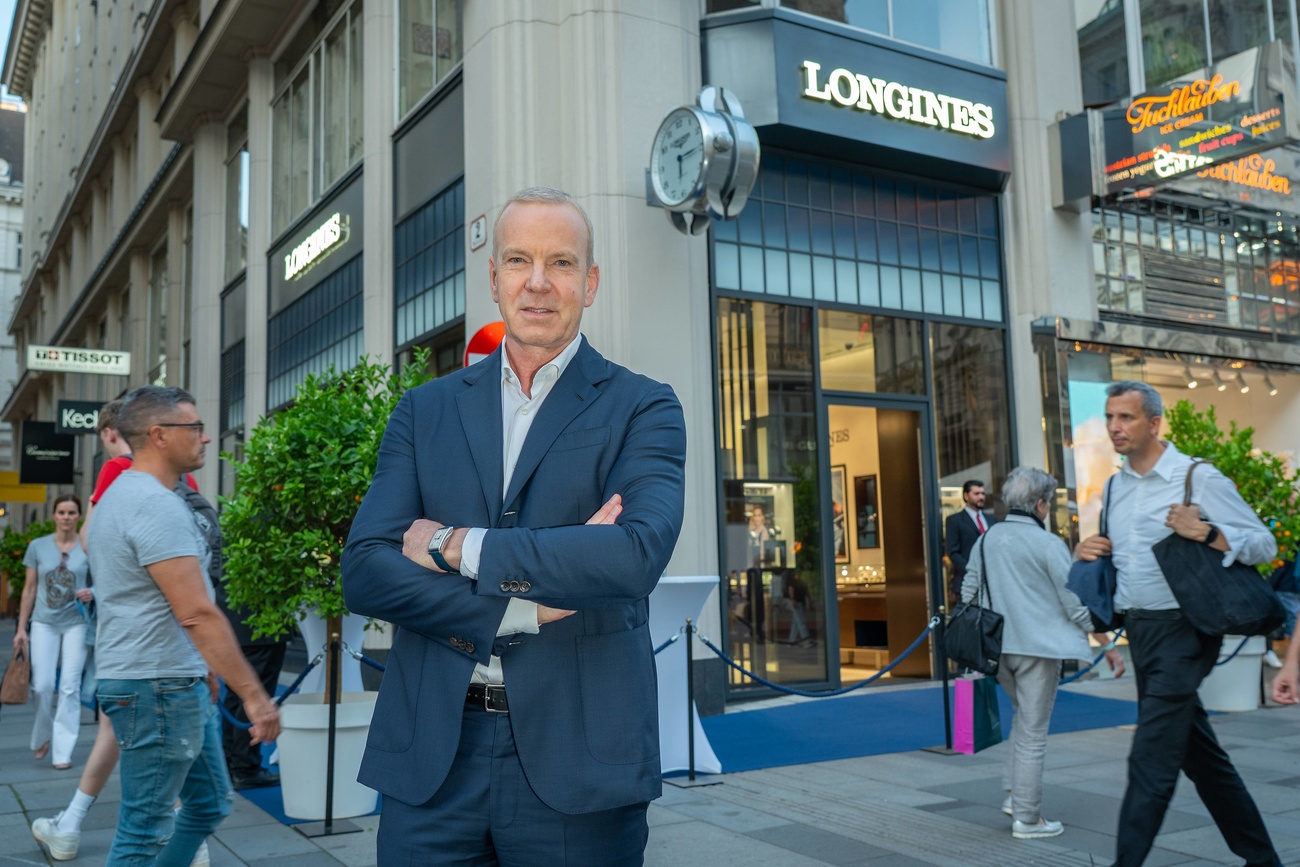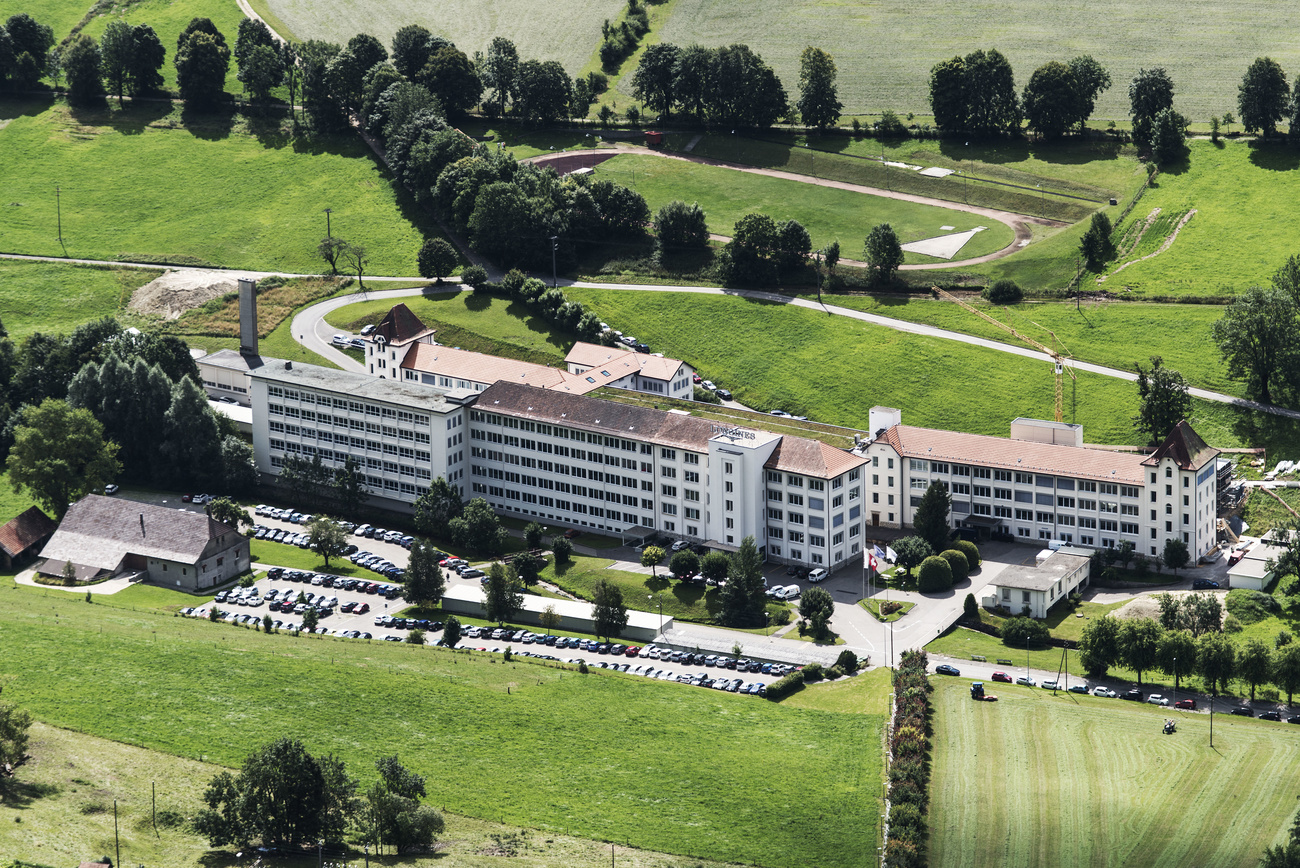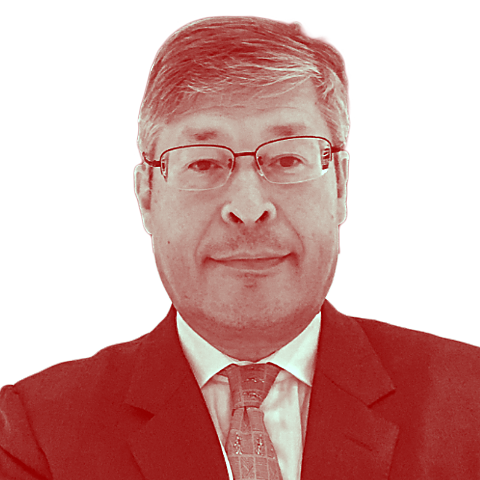
‘Buying a watch remains a deeply emotional act’

Unlike other Swiss watchmakers, Longines enjoyed good growth in China this year. It remains confident about the future of the Chinese market and others. Matthias Breschan, CEO of Longines since 2020, spoke with SWI swissinfo.ch about the brand’s strategy.
Founded in 1832 in Saint-Imier, Longines is proud of its roots in this small town in the Jura mountains of canton Bern. It is proud, too, of its technological innovations.
According to estimates from Morgan Stanley and LuxeConsult, Longines’s 2022 sales exceeded CHF1.2 billion ($1.3 billion). This clearly positions the company, which is part of the Swatch Group, among the top ten Swiss watch brands.
SWI swissinfo.ch spoke with the CEO of Longines, Matthias Breschan, an Austrian citizen, at the company’s historic headquarters in Saint-Imier.
Matthias Breschan, an Austrian citizen, graduated from the Vienna University of Economics and Business. He joined Swatch Group in 1996 as a Regional Sales Manager Swatch and went on to manage the Hamilton brand and then the Rado brand.
Since 2005, Breschan has been a member of Swatch Group’s Extended Group Management Board, where he is responsible for Swatch Group in Taiwan and Austria.
In 2020, Breschan was named CEO of Longines.
Before he joined Swatch Group, Breschan worked for Texas Instruments and Alcatel Mobile Phones in product marketing, international marketing, and sales.
SWI swissinfo.ch: In July 2020, you succeeded Walter von Kaenel, who had run Longines for 32 years. How did the transition go?
Matthias Breschan: With respect and modesty. Longines is one of the most successful Swiss watch brands, and this is largely due to my predecessor. In this context, it wasn’t up to the Longines brand to adjust to its new CEO but rather up to the CEO to adapt to the brand. I therefore studied the reasons for Longines’s success in order to perpetuate it. I am also making sure the brand’s evolution respects the past.
SWI: To what exactly do you attribute the success of the Longines brand?
M.B.: Longines has three key elements that differentiate it. The most important is our history. In the Swiss watch industry, Longines has, I believe, the most remarkable heritage. This is due to valuable inventions such as GMT [simultaneous display of the time for two different time zones] and flyback [the ability to restart a stopwatch without having to stop it first], as well as mastery of high frequencies. The latter technology was critical for the development of precision stopwatches.
This heritage holds great importance not only for collectors but also for the younger generation in search of high-value products built to last a lifetime or longer.
Furthermore, we’re the only brand in our [market] segment that has enjoyed equal success with both men and women.
Lastly, our classic and our sport collections have done equally well.
In the future, I intend to accentuate these three distinctive elements even more.
SWI: In designing new models, do you rely more on intuition or on market research?
M.B.: I rely on the three elements that differentiate us that I just mentioned. To define the future, it’s essential to look at the past and evolve from there. In other words, when developing new products it is vital to maintain authenticity and not create a message that strays from your heritage. This approach is what makes our products unique and inimitable, whether by our Swiss competitors or by those based abroad.
SWI: Swiss watchmaking as a whole is going from record to record, with exports likely to reach a new peak this year. How is Longines doing?
M.B.: I started working for Longines in July 2020, at the height of the [Covid-19] pandemic. At that time, all of our 4,000 points of sale in 150 countries were closed. Luckily, in August 2020, the Asian market started to show signs of recovery, thanks largely to China and to the strength of our brand. The year 2022 was an exceptional one for Longines, and we await the 2023 [sales] figures with a lot of optimism.
SWI: The recent sales figures for Swiss watchmakers have been excellent. But the volume of sales has fallen sharply. Could some of your suppliers suffer from this trend?
M.B.: Our brand has slightly increased both its unit prices and its production volume. In other words, we’re not facing any problem of insufficient volumes for component production.
In addition, the Swatch Group benefits from strong vertical integration thanks to our own factories that produce watch components, including movements (ETA), dials (Rubattel & Weyermann), hands (Universo), and cases (Ruedin). Furthermore, our group is present in every market segment. All of this helps us manage our production volume at the group level.
SWI: In which countries are you aiming for strong sales growth?
M.B.: In 2022 and 2023, our growth was excellent in all of the key countries, including the United States, Europe, Japan, southeast Asia, and Australia.
SWI: Aren’t you overly dependent on the large Chinese market, which is struggling with a slowdown and a real-estate crisis?
M.B.: Actually, unlike other brands, we’ve recently experienced good growth in China, and we remain confident about the future of this market.
SWI: What about the Indian market, which is currently very sought-after?
M.B.: Our sales in India are also booming, and we believe this market is very promising. That said, compared to China, the market in India is starting from a much more modest base.
SWI: What is your opinion about online sales, especially about the ability to convey emotion on a screen?
M.B.: Throughout the two years of the pandemic, we expanded e-commerce considerably. When I arrived at Longines, we only sold via the internet in six to eight countries. Currently, we sell our watches online in the 33 countries where we have subsidiaries, and these sales represent 5% to 10% of our total sales.
I’m firmly convinced of the synergies between an online presence and the existence of physical boutiques. On the internet, our customers can research our entire collection in depth and at any time, day or night.
Yet buying a watch remains a deeply emotional act, a way of reflecting your affinities and your personality. As a result, the majority of our customers prefer to finalise their purchases in a boutique.
SWI: Some luxury brands swear by direct sales, a growing trend in the watch industry.
M.B.: Among our 4,000 points of sale worldwide, only 260 boutiques are dedicated exclusively to the Longines brand. What’s more, only half of these boutiques are run directly by Longines. In other words, our strategy doesn’t rely at all on dogmatic promotion of direct sales. We analyse each market individually. For example, it’s often true that the optimal solution for a given area is to collaborate with a well-established multi-brand boutique.
SWI: What do you think about the growth of the secondary market, in particular for CPO (certified pre-owned) watches?
M.B.: Basically, we don’t target this segment of the market. However, in the collectors’ areas of our own boutiques, we’re giving more and more importance to showcasing our heritage, as we do in our museum in Saint-Imier.
SWI: This museum would attract many more visitors if it were in Zurich or Geneva…
M.B.: But that’s precisely what we don’t want! On the contrary, we want those who love our brand to come to Saint-Imier to experience the strong watchmaking tradition of our region.

SWI: Does your location in an outlying region complicate recruiting at a time when many Swiss watchmakers are struggling with a lack of skilled labour?
M.B.: Longines established its roots in Saint-Imier from the start in 1832. Many of our current colleagues have worked for the company for 10, 20, even 30 years. This highlights the wealth of technical, commercial, and logistical expertise within our local population.
In other words, it’s not difficult for us to recruit skilled labour locally, except in emerging fields such as e-commerce and digitisation. But this shortage of new specialists is a challenge that affects all of Switzerland, including cities like Zurich and Geneva.
Edited by Samuel Jaberg. Translated from French by Katherine Bidwell/gw

In compliance with the JTI standards
More: SWI swissinfo.ch certified by the Journalism Trust Initiative





























You can find an overview of ongoing debates with our journalists here . Please join us!
If you want to start a conversation about a topic raised in this article or want to report factual errors, email us at english@swissinfo.ch.